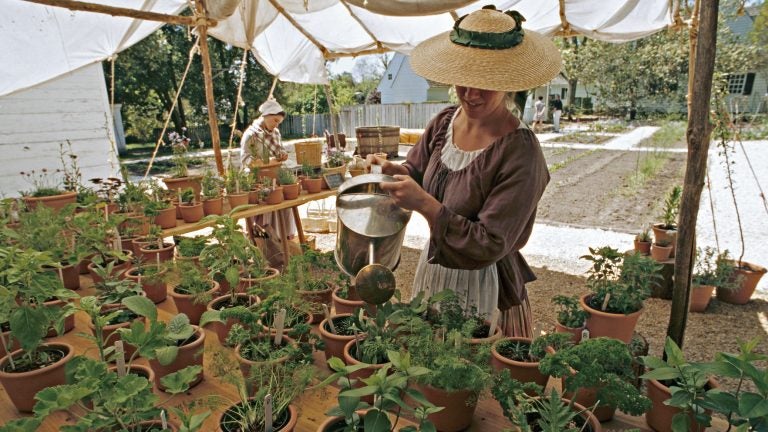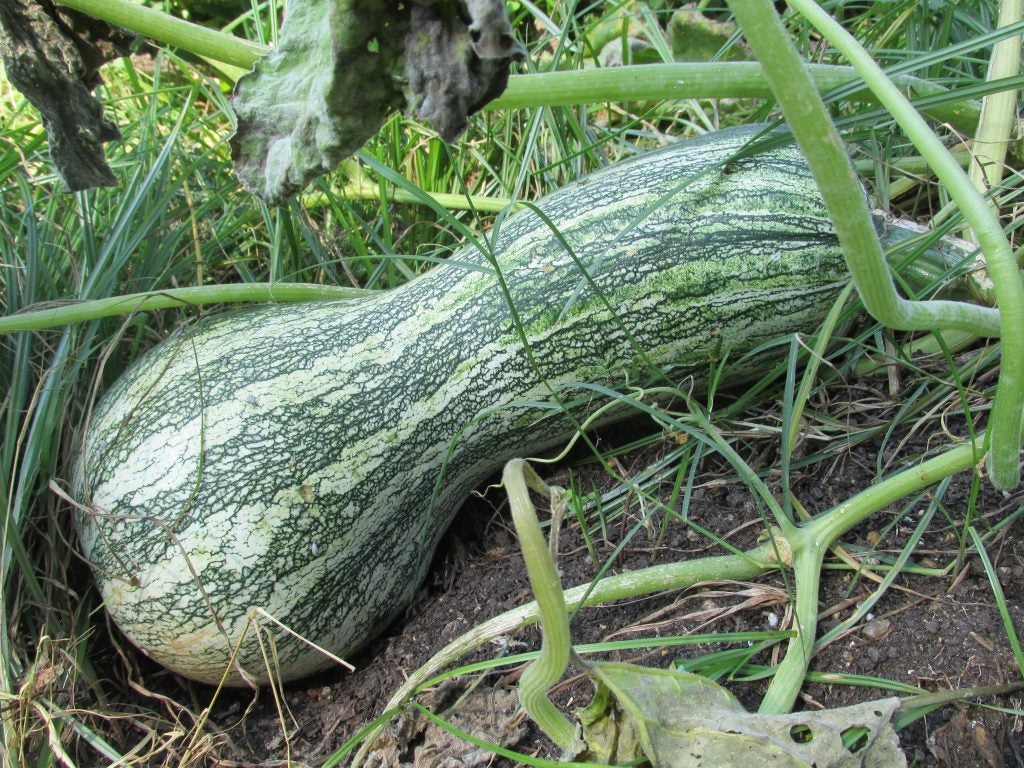Colonial Williamsburg serves up the past so you can try a taste of history

At Colonial Williamsburg's garden and nursery, which is open to guests, staff grow items that would have been found in gentry pleasure gardens: herbs, flowers and seasonal greens. (Colonial Williamsburg Foundation)
Just a few blocks past a college bookstore, modern restaurants with beer flights and big-screen TVs, and gift shops selling the same trinkets you’d find in any tourist town in America, you might wander onto a cobblestone street.
A rooster crows. The smell and sound of horses drifts in the breeze. Women go about their business dressed in caps and petticoats; men wear breeches, perhaps a cravat.
Colonial Williamsburg, Va., the 300-acre living-history museum, is a place where people stumble into the past, whether it’s talking to the bookbinder stitching pages by hand or the people growing long-forgotten fruits and vegetables.
Since restoration began in 1926, the dream of preserving this section of Williamsburg has come to include the chance to taste history.
There is a foodways program, through which people in colonial garb cook year-round over an open fire using culinary technology only available in the 18th century.
And then there are farmers like Ed Schultz, who sows fields with turnips, tobacco, corn and cotton using literal horse-power; or Eve Otmar, a journeyman gardener who tends to the “gentleman’s garden,” which includes flowers in the summer and expensive glass frames that allow lettuces to be grown all year.
“We have prickly pear in our garden,” Otmar says. “People are horrified, surprised and stunned.” She tells the story of how a woman who had lived in Virginia for 52 years once told her she had never seen a prickly pear. “They’re native here,” Otmar says.
While guests can often buy seeds to take home or sample some of the edible produce if they’re lucky, the relationship between the foods of past and present get a little murkier in Colonial Williamsburg’s many restaurants.
Guests might think they want a taste of the past, but their thoroughly modern palates often disagree.
“When you look at re-creating historic recipes, sometimes it doesn’t taste that good,” says Travis Brust, head chef of the Colonial Williamsburg Inn. “A lot of things seem to be overcooked. It doesn’t have the seasoning profile you’d expect.” Making the past come alive — foodwise — is often a matter of trial and error. A ginger cake the colonial restaurants serve around the holidays took at least 10 attempts before they got the sugar and spices to a level that seemed palatable.
Brust explains that spices were expensive in colonial America. “You could have paid your rent in cardamom, and now you can get a bottle for $4.” If an 18th-century American dined out at one of our restaurants, he says, “they’d think our food was way too salty and over-seasoned and had a ridiculous amount of herbs in it.”

The other challenge is dealing with aesthetics, Brust says. Turnip stew is a tough sell as-is in the restaurant. “It’s been cooked for hours and hours and it’s very tender and flavorful, but all the green has left — it’s turned brown,” he explains. “When you look at re-creating it, maybe you leave the greens out and do a quick sauté, then fold them in at the end.” It’s what George Washington would have eaten if he had Instagram.
Brust bases his menus partly on what the Williamsburg gardens and farms will be harvesting. “They know when the radish crop is going to be done and they’ll let us know the different stages of carrots.” He uses carrot tops, baby, adolescent and full-grown carrots in slightly different ways.
Schultz grows a lot of vine plants, ranging from pumpkins to cushaw squash, a common variety in 18th-century Virginia that’s sold as an heirloom vegetable today. It isn’t a seasonal kitchen item, but instead comes by the wagonload. “We get it all at once,” Brust says. “We candy it, dehydrate it, turn it into ice creams, bag it into sous vide bags and make raviolis out of it. It’s almost to the point where we can’t use it all because there’s so much of it.”
Some 18th-century plants have been easier to rediscover than others. Schultz is still trying to find a plant known as the “Hanover turnip,” mentioned in sales records from the store of a local merchant, John Carter, with limited success. Carter’s shop sold everything from swans, chickens and hedgehogs to imported garden seeds and molasses.
Despite growing in Virginia in the 1700s, the Cypriot Melon didn’t come back to Colonial Williamsburg until a seed company traveled to Cyprus and discovered an interesting-looking fruit for sale at a local food market, says Otmar. “It answered the description we had from the 18th century,” she says. The staff relies on anything from written descriptions of taste and smell to old drawings and paintings to help either rediscover or recreate crops through careful breeding — with less terrifying results than Jurassic Park.

The different culinary trades of Colonial Williamsburg didn’t always work together as smoothly as they do today, says Schultz. People are constantly asking him what he does with the corn he grows. “They want to know it’s a full circle, that this really goes to livestock or really goes to someone’s belly.”
Today, the food grown on the premises rarely goes to waste. When the kohlrabi (German turnip) started to swell from the heavy rains Virginia experienced last summer, the culinary staff had an emergency harvest of baby kohlrabi. “We ended up confiting them, peeling, slicing, and [cooking them] in a fragrant olive oil to use as a one-night special,” Brust says. “We saved the crop.”
Tove K. Danovich is a journalist based in Portland, Oregon.
9(MDAzMzI1ODY3MDEyMzkzOTE3NjIxNDg3MQ001))




